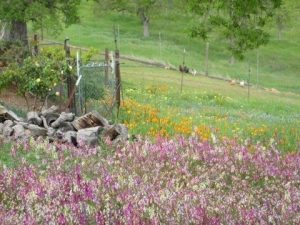When selecting new plants or considering the replacement of old ones, it is advantageous to match the plant with the area. This gardening technique is referred to as “Right Plant – Right Place.” It is the second principle of “Foothill-Friendly Gardening.”
Our foothill climate – referred to as a Mediterranean climate –is one of wet, cool winters with hot, dry summers. There are a limited number of places on the planet with this particular weather pattern. It occurs in most of California, parts of Australia, South Africa, central Asia and central Chile. It all has to do with high pressure zones that shift toward the poles in summer and toward the equator in winter.
“Exotic” plants that are not adapted to this rather forbidding weather pattern come at a huge cost – an insatiable thirst for irrigation water, fertilizer to help them survive, and labor to care for them. Choose natives and Mediterranean-adapted plants instead. Landscape specimens that developed and evolved survival strategies in response to this all-or-nothing climate fare much better, requiring little water, no fertilizer and almost no care (once established).
There are many resources available to gardeners, home owners and nursery customers through the University of California. A wonderful website hosted by the UC Davis Arboretum is the Arboretum All-Stars. This site contains a list of 100 plants that have been Master Gardener tested for growing success in various parts of California. You can learn about the All-Stars irrigation and climate trials, download a descriptive brochure and find out when the arboretum will host a sale. The all-stars database allows you to search for the right plants for your garden. The site provides garden plans for a California native garden, a low maintenance garden and a wildlife-attracting garden.
Another favorite source of information about California native plants is the website hosted by Las Pilitas Nursery. In addition to a wealth of information about California plants, there is an area where you can enter your zip code and find a list of plants that are appropriate for your area here. It is fun to find out the type of environment that existed originally where you live and the list of appropriate plants is extensive to the point of being overwhelming. You can look up your favorite plant by scientific or common name. Or you can research California oaks or sages or find out what plants flower during various months.
If you are looking for landscape trees, California Polytechnic State University, San Luis Obispo (Cal Poly) hosts an informative website call “Selectree.” Created by the Urban Forests Ecosystems Institute, the site allows you to search for appropriate trees by name or characteristics. In addition, the link to “Right Tree Right Place” provides utility precautions, fire safety, root damage, invasiveness, allergens and toxicity, etc. Their information about tree maintenance states, “Appropriate tree selection for your planting location will lessen maintenance pruning and excessive green waste.” And they provide an extensive guide to pruning developed by the U.S. Forest Service.
Please remember, if you are planning to add trees, shrubs, and perennials to your landscape, they are best planted in the fall. The soil temperature is still warm, the air is cooling and Mediterranean and California natives are awakening from their drought-induced dormancy. Planting in the fall allows them to become established while there is, hopefully, moisture available before they face our summer heat.
Whether you replace a single plant, add a better-adapted specimen, or rehabilitate a generic, suburban space, enjoy the beauty of these websites and have fun planning a “Right Plant – Right Place” landscape.
Rebecca Miller-Cripps is a University of California Cooperative Extension Master Gardener of Tuolumne County who loves California oaks.




